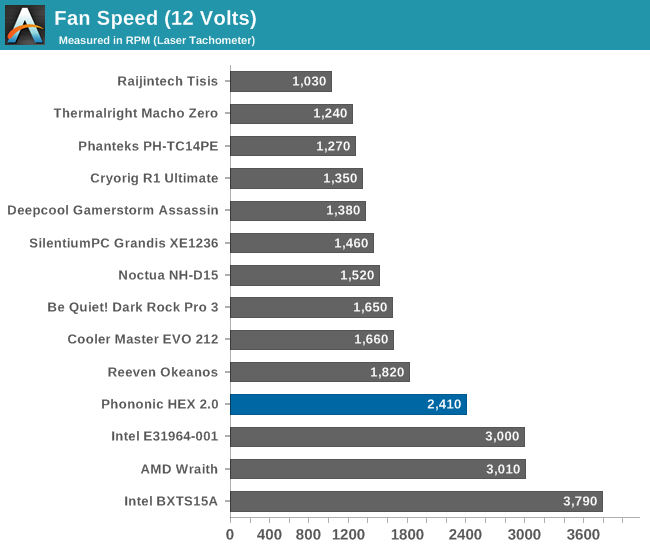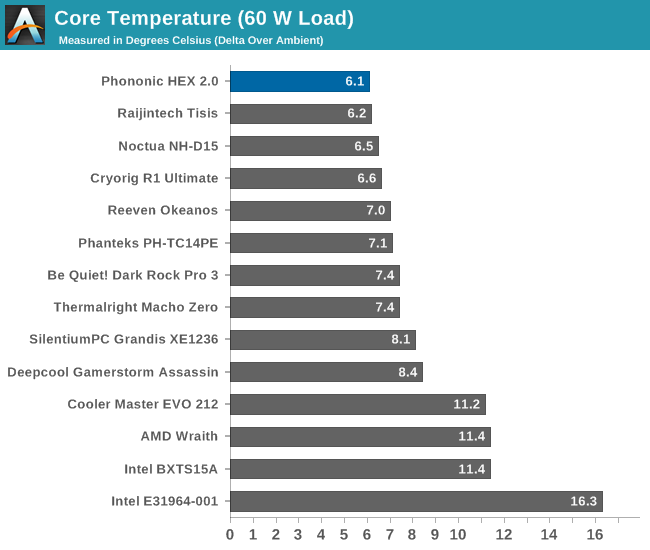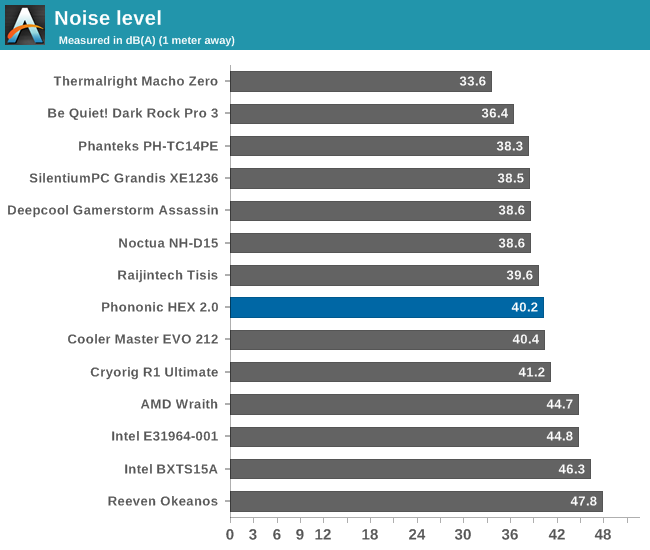The Phononic HEX 2.0 TEC CPU Cooler Review
by E. Fylladitakis on September 26, 2016 9:30 AM EST- Posted in
- Cases/Cooling/PSUs
- Cooler
- TEC
- Phononic
- HEX 2.0
Testing results, maximum fan speed (12 Volts)
The thermal performance of the Phononic HEX 2.0 is a relatively complicated topic. Most typical coolers have a relatively steady absolute thermal resistance regardless of the load or, depending on the cooler’s mass, the absolute thermal resistance slightly decreases as the temperature difference increases. The HEX 2.0 shows the completely opposite behavior; it’s absolute thermal resistance is very high at lower loads but it sharply degrades at higher loads. This happens because, in layman’s terms, the TEC cannot cope with the excessive thermal energy while, at the same time, it inserts its own thermal losses into the system, leaving the relatively small tower cooler to cope with much more than just the chip it is supposed to be cooling.


| Core Temperature, Constant Thermal Load (Max Fan Speed) |
The average thermal resistance of the HEX 2.0 is 0.1459 °C/W, which seems to be poor considering the target audience of this cooler. However, the thermal resistance of the cooler with a low thermal load of 60W is 0.1017 °C/W, easily rivaling the largest of tower coolers and even liquid cooling solutions. As the load increases, the thermal resistance of the HEX 2.0 decreases, particularly with thermal loads above 200W. With a thermal load of 340W, the thermal resistance of the HEX 2.0 drops down to 0.1685 °C/W, hardly competing with the performance of budget-oriented and stock coolers.

As for the energy consumption, the HEX 2.0 will almost entirely disable the TEC for thermal loads below 20W to minimize consumption and will prevent condensation issues. It will not push the chip to temperatures below the ambient in its balanced mode. If set to the insane mode, the TEC will always operate at maximum mode and could possibly get the CPU to register temperatures below the ambient, but only if the thermal load is very low.

Aside from it turning the TEC off completely, the TEC controller virtually has two operation modes; half power and full power. The controller decides when to set each mode depending on the thermal load and the ambient temperature. Roughly, the TEC shuts down for a thermal load below 15W, it operates at half-power mode for a thermal load between 15W and 90W, and goes at full-power mode for a thermal load above 90W. The TEC itself consumes about 20W at half power mode and 40W at full power mode, with the exact value slightly varying depending on the temperature. Note that a large percentage of this energy consumption is inserted as additional thermal load for the cooler to dissipate.










48 Comments
View All Comments
MrSpadge - Tuesday, September 27, 2016 - link
Cooling at low power consumption levels (up to ~30 W) is very easy with modern coolers, unless you are restricting the hot air exchange with the environment (those HTPCs which for some reason have to be super small). If you're interested in such cases it would make more sense to test the case & envirnonment rather than the cooler itself.60 - 100 - 150 W covers typical CPUs under load very well, with 200 - 250 W representing overclocked socket 2011 chips and 340 W the extreme.
BurntMyBacon - Monday, September 26, 2016 - link
It would be interesting to see the crossover point between half on and full on. The aircooler isn't particularly large and doesn't seem to dissipate heat fast enough to keep up with the TEC. While providing a larger delta between the hot and cold plates, adding an extra 20W for the air cooler to deal with can, in some circumstances, actually increase the steady state temperature.A good test (that I'm not sure this kit would let you run) would be if you could test several TDP points at both half (20W) and full (40W) TEC power. I imagine you would see full power come in cooler up to the point that the air cooler starts failing to keep up. Switching to half TEC power would then be more efficient as it would dip back under that threshold. Once you increase thermal output to reach that threshold again, it would be interesting to see which mode works better with an overburdened air cooler. In the past, I've was told to use TECs with water cooling systems as air coolers at the time always got overburdened too early.
Avenger762 - Monday, September 26, 2016 - link
Once again, this thing is no match for my old CM V10. BTW the V10 in my tower has been running since 2006 with the exception of a couple of motherboard and fan replacements.VeauX - Monday, September 26, 2016 - link
it would be nice to see it compared to :1 - same size air cooler (comparable cu.cm or length / height / width)
2 - same price coolers including AIO Liquid Coolers
HomeworldFound - Monday, September 26, 2016 - link
I used to own a Thermaltake Subzero 4g Thermoelectric Cooler, used on a Pentium 4. This does seem like an evolved version of that. The Thermaltake used up a PCI slot and was oversized by 3/4 of an inch. There wasn't any condensation to deal with but I can't really say that it worked well.andychow - Monday, September 26, 2016 - link
Ask any physicist, and they will explain to you why thermoelectric cooling is a terrible idea. It's only if you need a specific solution, such as bellow ambient. Otherwise, it's super inefficient.powerarmour - Monday, September 26, 2016 - link
Yo dawg, I heard you need a cooler to cool your cooler?RaistlinZ - Monday, September 26, 2016 - link
I was interested in this until I saw the performance.Then I saw the price, and became even less interested.
benzosaurus - Monday, September 26, 2016 - link
In which we learn that "refrigeration" and "heat dissipation" are distinct and incompatible concepts.jlk440 - Monday, September 26, 2016 - link
Thanks for an interesting review. I'm puzzled by your reversal of the meaning of thermal resistance. Lower number = lower resistance = fewer degrees difference per watt of heat. For heatsinks, you want thermal resistance to be LOW, which means heat conductivity is HIGH. For some reason your terminology incorrectly calls lower resistance numbers "higher resistance", so maybe you mean higher conductivity (the opposite of resistance).